|
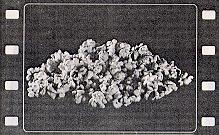 ZEA
(5
min. 17 sec.) ZEA
(5
min. 17 sec.)
DESCRIPTION
A
mysterious film with ballet-like movement accompanied by the grandeur of
symphonic sound, ZEA will intrigue and puzzle your students. Undeniably
beautiful, it presents real challenge to the EFL/ESL teacher.
Since it lacks both storyline and verbal language, it must be approached
for the aural and visual stimulation it brings to your students.
Following are a few suggestions to get you started.
VIEWING
Students
should have pens and paper at the ready before "START" is pushed on the
VCR. This is a guessing game without the $64,000 prize. But there will
be a payoff in interest! Get your students to watch attentively and as
soon as they identify the mystery object in the film, to write its name
on a piece of paper and their own name on the blackboard. After the viewing,
review their answers in order and ask them for clues and reasons that led
to their conclusions. Even "wrong" answers arc valid examples of ZEA offers
great opportunities for building lists of descriptive words, for speculation
(What might your guess have been, and how would the mood have altered if
the film had been accompanied by synthesizer, rock, or calliope music?)
It opens the way to discuss scale, distortion, and perception.
ADDITIONAL ACTIVITIES
*
Divide the class into small group. Each group selects a common object such
as an apple, a shoe, or a comb. Students prepare a list of descriptive
words for the object viewed from close-up, where it's never visible as
a whole. After a given time, each group leader in turn describes
the characteristics of her or his group's object, while the other groups
try to guess what it is. |
|
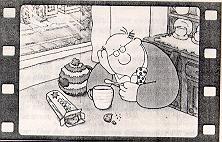 GEORGE
AND ROSEMARY (8 min. 48 sec.) GEORGE
AND ROSEMARY (8 min. 48 sec.)
DESCRIPTION
A romantic comedy about
two aging neighbours, GEORGE AND ROSEMARY is Whimsy at its best.
WHimsy, already a new word for your students to learn! But there
is more in this delightful tale. Enough to touch even adolescents
with the pain and poignancy involved in taking those first tentative steps
in relationship building.
The film is really quite
easy to follow, even by viewers with limited listening comprehension.
Of course there will be new words and expressions to learn, such as passion
and relative happiness, but these need not be introduced before the viewing.
VIEWING
Establish the ideas of reality
and fantasy before playing the video. You may invite your students
to share their own experiences in this realm. If fantasy is too embarrassing
for personal recollections, your class members will each know at least
one fairy tale or legend involving fantasy, from their own culture. And
it's never difficult to find examples of reality!
Attar the video has bean
shown, talk about how it is often easier to do thing in fantasy than in
real life. But sometimes it also works the other way! Examples please!
Start by having students describe each of the fantasy sequences in the
film, then get their own memories and imaginations working.
If they can't remember a
suitable personal experience they can make one up. How was the experience
before it happened? As it was flitting around in the comfort (or discomfort)
of the imagination? Then, it really happened. What was the difference in
happenings and in feelings between the fantasy and the reality? To get
things started you can always make up a few examples such as:
--your first meeting with
someone you really admire;
-- an interview for a job
you desperately want;
---entering a competition
(sports, music, cooking);
-- a "blind date."
ADDITIONAL ACTIVITIES
* Improvisations will work
well with GEORGE AND ROSEMARY The teacher describes a situation involving
two people. A pair of students act out the fantasy parts with appropriate
dialogue for their thoughts. Another twosome does the same for the reality
roles--what really happened.
* Choose sequences in the
film such as George's actual arrival at Rosemary's door. Create dialogue
for these moments.
* Change the roles or characters
of George and Rosemary.
For instance, she's shy
and he's bold. Or she's aggressive
and he's receptive. After
establishing their new characters,
collectively build up the
story and the dialogue between
the two, and write it on
the blackboard. Then act it out in
short scenes giving all
students a chance to participate.
TEXT FOR GEORGE
AND ROSEMARY
There's nothing too difficult
here except perhaps for the pleasure of her company and dug into (ate heartily).
Narrator: George Edgecomb
lived on St. Basile Crescent, at number 42. On cold and rainy days he would
stay snug indoors, playing checkers with his cat, putting ships in jars,
or watching TV with a pizza. While on better days, when the sun was nice
and warm, George would sit on his front porch, watching whatever passed
by. There was, however, a more important reason; for his outdoor activities.
He had a passion for the lady across the street.
Narrator: One day, thought
George Edgecomb, l will ask Rosemary Harris for the pleasure of her company.
But not today. Tomorrow, thought George, will be the day.
Narrator: When George woke
up in the morning, he put on his best shirt and tie, matching socks, and
dug into a nice plate of bacon and eggs. George picked a bunch of flowers
from his garden, and went to have a final inspection in the mirror. George
thought he would cal first.
Rosemary: Hello! Hello!
Is that you Alice? Hello?
George: Hum ... Hum ...
Hum...
Child: Do you want to buy
some cookies, mister? Chocolate chip.
Rosemary's Family: Hello!
Hi!
Teenager: Evening, Mr. Edgecomb.
George: Hum... Hum... Hum...
Narrator: And so George
sold his house, and he and the cut moved across the road to Rosemary's,
where they all lived together in relative happiness, for the rest of their
lives.
|
|
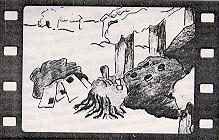 SPECIAL
DELIVERY ( 7 min. 7 sec.) SPECIAL
DELIVERY ( 7 min. 7 sec.)
DESCRIPTION
This is not your ordinary
simple story! Why didn't Ralph clean the snow off the front steps
when his wife Alice told him to? If he hadn't ignored her request
it might well have turned out to be another humdrum day. But then,
there'd be no SPECIAL DELIVERY! This sophisticated Academy Award winner
looks like a mystery and sounds like a soap opera. One misadventure
leads to another, and don't expect a conventional conclusion! But
please preview it first. It may be too difficult, sophisticated,
or even offensive to some of your students!
A little straightforward
vocabulary preparation is advisable. But there are injury ways to
introduce new words and they're not necessarily boring. As you read
over the transcript you'll probably note words like stupor, reflex,
misapprehension, bail, coroner, Surmised, wrath, and remorse.
Look at some of the phrases and expressions such as A Problem struck him!
and to steady his nerves. Let your students draw a new phrase or word front
a hat the week before you show SPECIAL DELIVERY. The following
week, before the viewing, they Ought each use their "prize" vocabulary
in a brief paragraph which explains its meaning.
VIEWING
When the video ends, a simple
retelling of the story will quickly signal whether students understood
it. If not, play it again immediately. It's a classic which stands up well
to many viewings.
Ask students to re-use the
phrase or word they drew from the hat, but this time specifically in a
sentence related to the video.
ADDITIONAL ACTIVITIES
* Retell the story using
what ifs.
--What if Ralph had remembered
his key when he went out to deliver the mail?
--What if Ralph's wife had
an affair with the mailman?
--What if his wife, had
not realized that the mailman was dead and had gone back home?
Above all, try to keep the
"what ifs" 11LImorous! Working in pairs will give students the most practice
in conversation. But sharing at least some of the stories with the whole
class contributes to motivation and group spirit.
* Four students (female
or male) play the roles of Ralph, the two policemen, and the magistrate.
They improvise the sequence in which the policemen take Ralph into court
to be charged. The policemen tell their story, Ralph tells his story (remember,
he can't admit it was his own house), the magistrate asks questions, then
lays charges and releases him on bail. Remember, this is a humorous story!
* Suppose that someone finds
the mailman dead on Ralph's steps. journalists from the local paper interview
Ralph and his wife. Four students take on the roles, and, working in groups,
ask their classmates to help them prepare dialogue. Then they dramatize
the situation.
* Students from other countries
could be encouraged to discuss attitudes toward the police and the legal
system in their homelands.
TEXT FOR SPECIAL
DELIVERY
The misadventures of Ralph
Phelps are told mostly with simple words except as noted previously. Three
phrases not mentioned before are turn himself in, drop the subject and
broken off with him.
Narrator: When
Alice Phelps left home that day to go to her judo class, she told her husband
Ralph to clean off the front walk before he left for work.
Alice: Is that
ail right with you?
Narrator: But
Ralph never did what his wife told him to do. When Ralph returned home
there was a body lying on his front stairs. It was the mailman! He had
obviously slipped on the ice that Ralph hadn't cleaned away, and broken
his neck. Ralph, fearing the wrath of the Letter Carriers' Union, carried
the body into the house. He decided that he would Put the body into the
trunk of his car and dump it somewhere... before anyone noticed that the
mailman was missing.
Narrator: A problem
struck him. If the police investigated the disappearance of the mailman,
there was a rather obvious clue Ail the houses on the mailman's route preceding
his own would have had a mail delivery that day. Those after his, would
not. Ralph wondered if he should turn himself-in. He remembered that a
mailman had once broken his leg on a friend's property, and that cost the
friend a lot of money. A broken neck was probably considered as bad as
ten broken legs! Ralph poured a drink to steady his nerves. Then he undressed
the mailman, and leaving the mailman comfortably in the living room chair,
put on the mailman's uniform and went out to deliver the mail.
Narrator: No one
noticed that it was Ralph delivering the mail, instead of the regular mailman.
When he got home, he found that his key was still in his own pants, not
in the mailman's pants. He tried to get in a window. He was spotted some
policemen in a passing police car. They accused him o~ trying to break
into the house. Ralph claimed that it was his own house. The policemen
were doubtful that a mailman could afford such a large house. Ralph remembered
that there was a body in his living room and dropped the subject. As they
were taking him away, a policema-n-7o-Td-Wa-l-p-h-th-aTre was a disgrace
to the Letter Carrier's Union. |
|
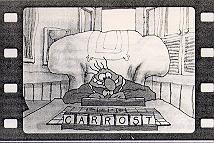 THE BIG
SNIT ( 9 min. 49 sec.) THE BIG
SNIT ( 9 min. 49 sec.)
DESCRIPTION
In THE BIG SNIT there
are two simultaneous "states of peevish annoyance" (The Penguin Canadian
Dictionary). A domestic quarrel is caricatured in a very funny way.
Then, mirth becomes poignancy as the second snit reveals itself.
Outside the narrow confines of the household squabble, a nuclear holocaust
is underway. The two faces of comedy and tragedy become one.
This is Academy Award nominee is known around the world for its sobering
yet humorous view of the human condition, and its thought provoking message.
Before viewing, an explanation
of s it is essential!
VIEWING
After playing the video
the first time, students will want to talk about it. What are the two snits
that are taking place at the same time? Are they really quite similar in
their origins? How are they the same and how are they different?
Discuss the "peevish
annoyances" of both husband and wife. The teacher might then lead off with
one of her/his pet peeves, and ask each student to express two of their
own. |
|
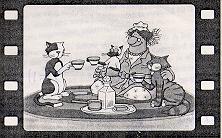 THE DINGLES
(7
min. 48 sec.) THE DINGLES
(7
min. 48 sec.)
DESCRIPTION
Alive, colourful, and with
a simple storyline, THE DINGLES can be used to stimulate discussion, develop
descriptive vocabulary and characterization skills, and engage in classification
as a language too]. But first, who are these Dingles? Doris
Dingle is the grandmotherly figure who presides over her family of three
cats, Donna, DeeDee, and Dayoh. Already you may see an opportunity
to introduce the idea of, if not the word, alliteration!
The story itself is very
simple. A sudden storm threatens their safety and only Doris' courage
and ingenuity saves the family.
Before playing the video,
read the text and single out any words which you feel should be introduced
to your students. You needn't review all new vocabulary with them
at this time, but You could at least introduce the cast by name.
VIEWING
Depending
on your class size, create five groups of students, each to focus on different
aspects during the video presention. One will note all descriptive
details of the storm. Another will attend to the appearance, behaviour,
and character of Doris Dingle. The remaining three will each choose one
of the cats, Donna, DeeDee, or Dayoh, to describe their personality and
physical attributes.
After
the viewing the groups will take ten minutes to prepare, their descriptions.
Ail students should participate in the oral presentations and while they
are being- given, one member of each group might list key words on the
blackboard. Groups should also be encouraged to replay the video without
sound, stopping it at appropriate moments to illustrate their descriptions
with sequences (or stills if the VCR is equipped for this)
ADDITIONAL ACTIVITIES
* Using the four characters
as examples, discuss stereotypes. Elicit from your students the stereotypes
of cats in their culture and from their personal perspectives. Extend
this to other animals.
In a multicultural group, compare these findings, and try to explain them.
* Try using the three cats
to develop notions of classification. Their behaviour rather than appearance
should be emphasized. Extend the process of classifying to foods, books,
and restaurants. Discuss the difficulties and limitations of classifying
things, as well as the advantages.
* Play with alliteration
using the cats' names to make up simple sentences. Extend this to two-line
verses which will also require rhyming. Language learning can be playful
and enjoyable.
* What's in a name? Discuss
how the cats' names suit (or don't suit) their personalities.
Extend this to the students, opinions as to whether their own names
suit them.
TEXT FOR THE DINGLES
There is a single voice,
that of the storyteller. Depending on your students' cultural backgrounds,
you may have to explain digging a hole to China, patio chairs, plastic
gnomes, whirligigs, union suit, and other expressions. Use the visuals
in the video to do this using the still picture or pause button.
Narrator:
Doris Dingle had three
cats, Dayoh, Donna, and DeeDee. And she loved them with all her heart.
Donna, a snobby Siamese,, spent most of the time sorting through her collection
of bird feathers. DeeDee Preferred to tap Doris Dingle's cheek with her
paw. Until Doris opened her mouth so wide that DeeDee could count her fillings.
Dayoh was just an all-around good guy who was digging a hole to China.
When Doris called him, she would yell "Dayoh, Dayoh!, " and he would come
bouncing, bopping, and hand-springing. Every day was a wonderful day for
the Dingles. But their favourite time was breakfast.
After eating, they would
drink cat mint tea in the sunshine. Then go about their business in the
backyard. One lovely day, Donna was
tanning her tail, while
Dayoh worked on his digging. DeeDee had just curled herself down into the
dandelion-picking basket, when something happened. It started out with
a little breeze that blew away a few feathers. Then a wind that tipped
over a big bag of peat moss. Suddenly a huge "whish" blew Doris Dingle's
skirt right over her head. When Doris looked up she saw a little poodle,
dog-paddling across the sky. Then Mr. Gonzo's union suit blew by like a
big red kite with a clothesline tail. Then his patio chairs and all the
plastic gnomes, flamingos and whirligigs. Just then, DeeDee
came flying right by her, and landed flat against the fence, spread out
like a maple leaf Then Donna... and Dayoh... and flower, pots, garbage
pails, and lawn chairs, and garden hoses, all dumped into a big rubble
pile.
But even though Doris
was very scared, she made a plan. Lifting her big apron, she tore the bottom
into three long strips. She tied one around each cat and then knotted all
three to the waistband of her apron. "Onward to the patio doors," Doris
shouted, and they were off
with their bellies to
the ground, as flat as bearskin mats. The lightning struck the fencepost
and shot the Dingles like missiles, right through the patio door into the
house. Safely inside, the first thing they did was have a nice hot bath.
While the storm flashed and crashed outdoors, Donna, DeeDee and Dayoh sat
in a circle on the rug, and had warm milk and honey with butter on
top. Doris had little cat mint cordial, settle her nerves. That night when
Doris went to bed, Donna, DeeDee and Dayoh crawled into Doris Dingle's
feather blanket. Two minutes later they were all zzzzzing (snoring)
as the rain pitty-pattered the roof Everything was just as it should
be. The end.' |
|
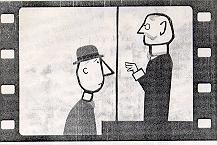 MY
FINANCIAL CAREER ( 6 min. 38 sec.) MY
FINANCIAL CAREER ( 6 min. 38 sec.)
DESCRIPTION
A fearful soul and his adventure
with The Bank, this film is based on a short story by the late Canadian
writer, Stephen Leacock. Set in an era when banks were all oak and
marble, and the manager sat pompously in his will-furnished office like
some minor emperor, MY FINANCIAL CAREER speaks of all encounters
between the timid and the mighty. Our " Mr. Milquetoast" sets out
to open a bank account with hilarious consequences. And maybe, just
maybe, it will remind us of experiences and feelings from our own lives.
Since there is a lot of
narration in this video, read the text first and introduce only those
new words which are crucial to the understanding of a first viewing.
You may want to give each student a word to look up and explain to their
classmates.
VIEWING
Direct attention to the
ways in which the filmmakers emphasize authority and power, and how they
depict weakness and humiliation. These themes can be
used for
post viewing discussion.
For example, as the video opens, a very small and meek-looking man is walking
up the steps of a huge, impressive, pillared building.
Discussion can follow other
lines as well. A list in sequence of the actions in the bank can be compiled
and then the
Discussion can follow other
lines as well. A list in sequence of the actions in the bank can
be compiled and then the man's "mistakes" identified. Discussion as to
what he should have done can follow. It might also be interesting to talk
about the bank staff and how they ought to have behaved.
ADDITIONAL ACTIVITIES
* Work in pairs or
groups of three to construct dialogue for the alternate scenario developed
in discussion. Mr. Milquetoast now becomes Mr. Minihero! Try replaying
the video without sound, with students reading or improvising the new narration.
* Complete sentences which
begin "I am (or "I was") intimidated by…". Begin sentences which
end "... is always intimidating. "
* Select other sequential
processes or situations such as starting a car, baking a cake, arriving
late for an important appointment, going to the dentist, or planting a
tree. First, record the process step-by-step. Ask Students to work in pairs
to dramatize each situation complete with commentary or dialogue. Encourage
humour. Their classmates can critique each process and propose corrections
to the procedures.
Talk about why My FINANCIAL
CAREER is funny.
* Get serious! With your
students' help, build up a list of current banking vocabulary. Discuss
the steps in opening a bank account, in depositing and withdrawing money,
and in
TEXT FOR MY FINANCIAL
CAREER
Although there is just
one voice, it takes on the parts of three characters---"My Milquetoast",
an accountant, and the manager. In addition to new vocabulary, some students
will not understand the references to Pinkerton's (a private detective
agency founded in the U.S.A. and now operating security services internationally),
Baron Rothschild (head of a famous international banking family whose
fortunes developed in Europe during the Napoleonic Wars), and Gould (early
American capitalist whose wealth came through control of railroads).
Narrator:
When l go into a bank,
I get rattled. The clerks rattle me; the sight of money rattles me; everything
rattles me. The moment I cross the threshold of a bank and attempt to transact
business there, I become an irresponsible idiot. I knew this beforehand,
but my salary had been raised by fifty dollars a month, and I felt that
the bank was the only place for it. So I shambled in and
looked timidly 'round
at the clerks. I had an idea that a person about to open an account must
need to consult the manager. I went up to a wicket marked 'Accountant.
" The accountant was a tall, cool devil. The very sight of him rattled
me. My voice was sepulchral.
"Can l see the manager?"
I said, and added solemnly, "atone. l don't know why l said "alone. "
"Certainly," said the
accountant, and fetched him. The manager was a grave, calm man.
"Arc you the manager?"
I said. God knows I didn't doubt it.
" Yes, " he said.
"Can l see you, " I asked,
"alone?" I didn't want to say "atone" again, but without it the thing seemed
self-evident. The manager looked at me in some alarm. He felt that I had
an awful secret to reveal.
"Come in here, " he said,
and led the way to a private room, He turned the key in the lock. "We are
safe from interruption here, he said. "Sit down. " We both sat down and
looked at each other, I found no voice to speak. "You are one of Pinkerton's
men, presume, " he said. He had gathered from my mysterious manner that
I was a detective. I knew what he was thinking and it made me worse.
"No, not from Pinkerton's,
" l said, seeming to imply that l came from a rival agency. "To tell the
truth, " I went on, as if I had been prompted to lie about it, "I'm
not a detective at alt. I have come to open an account. I intend to keep
all my money in this bank. The manager looked relieved, but still serious.
He concluded now that I was a son of Baron Rothschild, or a young Gould.
"A large account, I suppose,
" he said.
"Fairly large," I whispered.
"I propose to deposit fifty-six dollars now and fifty dollars a month regularly.
"
The manager got up and
opened the door. He called to the
accountant. "Mr. Montgomery",
he said unkindly loud, "this gentleman is opening an account. He will deposit
fifty-six dollars. Good morning."
I rose. A big iron door
stood open at the side of the room "Good
morning," I said, and
stepped into the safe.
"Come out, " said the
manager coldly, and showed me the other way.
I went up to the accountant's
wicket and poked the ball of money at him with a quick convulsive movement.
My face was ghastly pale. "Here," I said, "deposit it . " The tone of the
words seemed to
mean "Let us do this
Painful thing while the fit is on us. "
He took the money and
gave it to another clerk. He made me write the sum on a slip and sign my
name in a book. l no
longer knew what I was
doing. The bank swam before my eyes. Is it deposited?" I asked in a hollow,
vibrating voice.
"It is," said the accountant.
"Then I want to draw
a check. " My idea was to draw out six dollars of it for present use. Someone
gave me a checkbook through a wicket, and someone else began telling
me how to write it out. The people in the bank had the impression that
l
was an invalid millionaire.
I wrote something on the check and thrust it in at the clerk. He looked
at it.
"What! Are you drawing
it all out again?" he asked in surprise.
Then I realized that
l had written fifty-six instead of six. I was too far gone to reason
now. I had a feeling that it was impossible to explain the thing.
All the clerks had stopped writing to look at me. Reckless with misery,
I made a plunge. "Yes, the whole thing. "
"You withdraw your money
from the bank?"
"Every cent of it. "
"Are you not going to
deposit any more?" said the clerk, astonished.
"Never. " An idiot hope
struck me that they might think something had insulted me while I was writing
the check and that I had changed my mind. I made a wretched attempt to
look like a man with awefully quick temper. 777e clerk prepared to pay
the money.
"How will
you have it? " he said.
"What?"
"How will you have it.",
"Oh'', l caught his meaning
and answered without even trying to think, " in fifties."
He gave me a fifty-dollar
bill. 'And the six? "he asked dryly.
"In sixes, " I said.
He gave it to me and l rushed out.
As the big door swung
behind me l caught the echo of a roar of laughter that went up to the ceiling
of the bank. Since then I bunk no more. I keep my money in cash in my trousers
pocket and my savings in silver dollars in a sock.
|
|
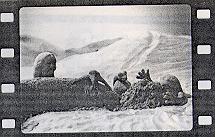 THE
SAND CASTLE (13 min. 12 sec.) THE
SAND CASTLE (13 min. 12 sec.)
DESCRIPTION
A child's seashore dream
of creating castles, walls, moats, and vast networks of superhighways,
takes on new meaning in this Academy Award-winning video. THE SAND
CASTLE is a modern-day creation myth. The creator himself emerges
from the shifting sands of endless time and sets about his work with boundless
energy. "The Sandman" not only creates a whole landscape of hills
and valleys, buildings and structures, but lie then proceeds to populate
this world with a strange assortment of living creatures, all well-adapted
to suit their specialized functions. An unscheduled visitor arrives
amidst this near-utopian bustle. The wind. And it blows and
blows. A video with i message, but without words!
|
|
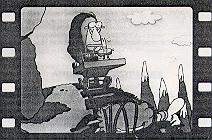 THECAT
CAME BACK (7 min. 37 sec.) THECAT
CAME BACK (7 min. 37 sec.)
DESCRIPTION
This zany interpretation
of an old folk song will set your students to tapping their toes, clapping
their hands, and joining in the singing. There's nothing like a
little music in the English class to overcome inhibitions, loosen up the
vocal cords, and add cultural richness through this common language!
As a bonus, THE CAT CAME BACK tells a good story and can be a real
discussion starter.
It all centres around old
Mr. Johnson and his yellow cat. AT first, their relationship is a
happy one. but it quickly turns to hatred. their adventures
and misadventures as the old man tries to rid himself of the persistent
and unwanted visitor are full of action, humour, suspense, and disaster.
Along with a simple introduction of the video, introduce the word goner.
VIEWING
During the introduction
the class should be prepared to meet imaginary and nameless creatures on
the screen and to make up a suitable name for each one. In literate cultures
this is a must, since "naming is knowing!" Ask students to keep their pens
at the ready to note not only the physical traits but also the behaviour
of each creature. In order to keep track of the new creatures until they
are named, they can be given numbers in order of appearance, beginning
with #1 for "The Sandman.
"The video is over. Now
the name creation game begins. Step one consists of associating the physical
features and behaviour of each creature with possible names. Build up a
double column on the blackboard. On one side list the attributes such as
"three legs," snake-like movement," "snout," "aggressive," "burrows." In
the other column begin to jot down descriptive words, prefixes, and suffixes,
which could be formed into novel names. "Tri" and "sits" (from the three-Iegged
-critter") could combine to be a "Trisits."
ADDITIONAL ACTIVITIES
* There are other ways'
to form names. " Try them. Playful rhyming is one approach. The creature
which rolls could be dubbed "Moler the Roller,"
* Try acronyms too. The
creatures with only heads and and arms who just keep on piling- up sand
rnight become the "Head & Arm Pilers," or "Haps" for short.
* Names can be totally arbitrary
too. Made from nothing as it were. Try this approach to give students opportunities
for free word play with the sounds of English.
* Finally, with your students
help, make a long list of English language given names, male and female,
on the blackboard. Let students argue their choices for the Sand Castle
People.
* Leave names alone for
a while. View the video again. Put the story into words. Take one sequence
and create dialogue for it. Dramatize as you might for radio.
* Discuss the story in terms
of sad and happy, optimistic and pessimistic. Give reasons for opinions,.
* Think of THE SAND CASTLE
as a great way to introduce prepositions; above, wider, behind, after,
around, up, through, near, below, during, from, toward...
* The film ends in silence.
Take the ending and continue it. What happens next?
* The moral of this story
is not stated, Get your students to decide "A at it means. |
|
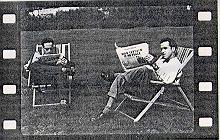 NEIGHBOURS
(8 min. 10 sec.) NEIGHBOURS
(8 min. 10 sec.)
DESCRIPTION
The story is a simple parable
about two neighbours. Their friendly relationship turns to hatred,
inspired by possessiveness toward a single pretty flower which springs
up on the border between their properties. Argument escalates to
violence, and in the end all is lost. NEIGHBOURS is a classic film with
an innovative technique. Made in 1952 by world-renowned animator
Norman McLaren, it won an Academy Award and continues to be acclaimed internationally
for its profound message and its artistic qualities. All done without
words, except for a concluding admonition in a dozen languages, "Love Your
Neighbour."
VIEWING
Introduce the video by asking
for the meaning of the word neighbours. After the first viewing, brainstorm
for the message of the film NEIGHBOURS. Ask students to contribute words
and phrases to a list you will build up on the blackboard. Then ask
to have each item used in a complete statement. Write these on the board
in numbered sequence. Each student will then choose the statement which
she or he considers most appropriate. Discuss and debate the choices.
ADDITIONAL ACTIVITIES
* Write paragraphs expanding
Upon the one-sentence statements of meaning. Write another one explaining,
your reasons.
* Retell the story either
orally or in writing, in groups or as a class. Use descriptive words to
express the feelings and mood.
* Create dialogue l for
the video. Dramatize with four students playing parts. Add a narrator.
Rewrite the ending to resolve the dispute in a civilized way. Dramatize
the new scenario. When developing dialogue, try to engage all students
in a collective effort.
* Imagine the film being
made today. Discuss differences that would be almost certain in a modern
version. The style of movement in NEIGHBOURS is called pixillation. What
kind of special effects would bc used now? Would the portrayal of the wives
be different"
|
|
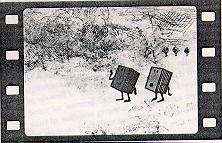 BALABLOK
(7 min. 27 sec.) BALABLOK
(7 min. 27 sec.)
DESCRIPTION
Antagonism and intolerance
as one facet of the human condition are vividly Portrayed in this world
by famous Czech animator, Bretislav Pojar. Cubes oppose spheres,
violence and prejudice transcend] reason and understanding, and in the
end, irony wins out. No dialogue or commentary is necessary.
The characters' sounds and actions tell everything. A fitting companion
to NEIGHBOURS, this video begs an answer to the question, "Isn't there
a better way?"
VIEWING
This video needs, only the
simplest of introductions. After viewing, ask what the war was really about.
Elicit descriptions of how the fighting ended. Relate the
conclusion to a recent world
situation where appropriate. Challenge students to suggest other ways of
preventing and settling disputes.
ADDITIONAL ACTIVITIES
* Get from your students
a list of human differences which can cause friction (e.g. colour, language,
habits and customs, personalities ... ), Ask them to choose one from the
list, and construct a simple statement giving one cause (e.g. Colour
causes friction because…). Discuss and debate the responses.
* Introduce the word escalation.
Ask for examples of escalation in the video.
* Prepare your own word
list based on the video (e.g. power, tolerance, stereotyping, fear, force,
brutality, aggression, peace, conformity, hatred ... ). Ask for sentences
using each Of the words in the context of BALABLOK.
* Compare and contrast
NEIGHBOURS and BALABLOK. |
 DISCUSS IT!
DISCUSS IT!
 DISCUSS IT!
DISCUSS IT!